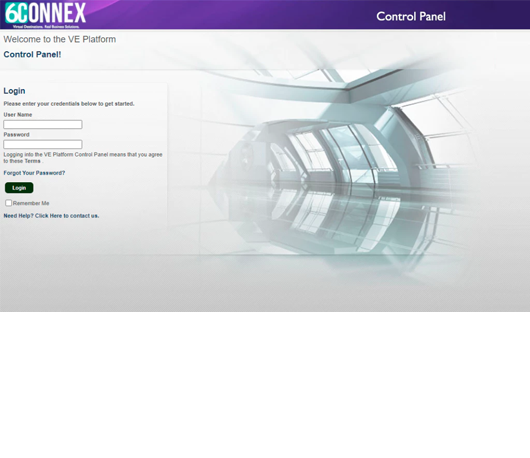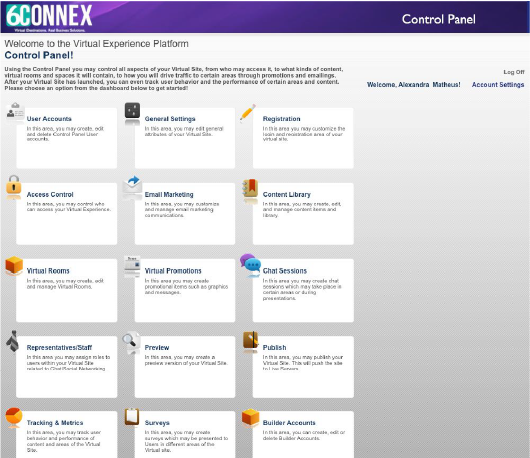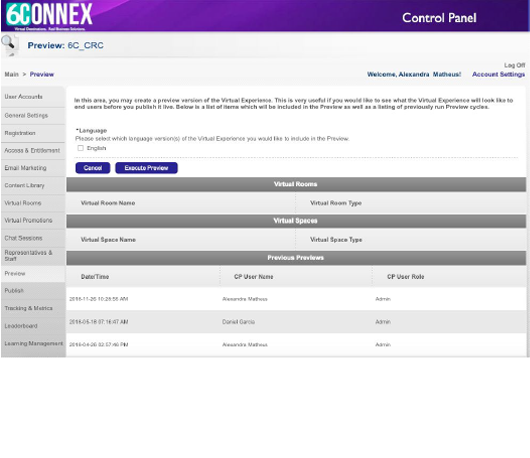Product Redesign
Backstory
- The 6Connex platform was long established as a leader with the virtual event space with a rich immersive attendee experience.
- The platform’s ‘control panel’ used to design virtual events was developed to be internally facing and generally sold as a ‘white glove’ service where events were developed by 6C professionals for customers.
- COVID-19 forced a necessary shift in the business model — self-service customers became the dominant user persona with the ‘control panel’.
- Dated UI/UX weighed heavily on user confidence by making the platform very difficult learn & use.

Project Goals and Parameters
Primary Scope of Work
- Control Panel ‘Lift and shift’ — functionality remains unchanged
- Improve usability and lower learning curve
- Achieve visual consistency and accessibility with updated UI
- Simplify collaboration & understanding of progress
Solutions Based on Scope
- Recommend high value upgrades. Design/document opportunities for future scope.
- New IA to create order and workflows.
- Develop and roll out a design system (DS).
- Expose system status/progress on all layers of platform structure.
Stage i — Discovery
Gaining Understanding
I began by diving into the platform to do an inventory of features, interdependencies and use-case journeys. At this point I had been with 6Connex for less than 6 months and still had a LOT to learn. I worked with client services, SMEs, engineering, event designers, and others to learn the many different ways events could be created.
Discoveries Made as part of the discovery phase:
-
- Typical use cases and journeys
- Personas
- Current site map
- User flows and feature requirements
- Identify interdependencies (Many more would be found)
A Wholistic Solution
A New Information Architecture to Enable Workflows and Simplify Navigation
It was well understood that the existing navigation and organization of the platform’s feature sets was confusing. A new information architecture reorganized the feature sets and the order which features were accessed when creating an event. Features were organized into logical flows (Top>down, left>right) that reflected a taxonomy based on the physical world. Event professionals’ (user’s) understanding of physical event creation would be leveraged for virtual event creation. The learning curve would be greatly simplified with intuitive workflows created by the new IA. The results of this phase were perhaps the most impactful aspect of the entire project.
As with any Agile project this ‘new’ IA was not quite final and would evolve as additional discoveries were made during the first few sprints as documentation was circulated and validated by more and more individuals of varying perspective. The end result was praised by users as an amazingly impactful upgrade.
Wireframe Exploration to reveal status and promote process
As the new IA structure was being validated I began to explore how to achieve the next goal of the project — giving user feedback of the progress/status of an event build. Understanding what is in progress, done, or not yet started is an important heuristic that enables teams to effectively collaborate when building even the simplest event. The plan established by the IA was to have a homepage (tier 0), tier I pages for major section branches, tier II pages for options and settings relevant to a single feature, and then some tier III pages for nested or advanced functions. Each page tier would need to give the status of the features contained therein.
A New Material Based Atomic Design System
With an international customer base leveraging the global recognition of Google Material was a logical starting point for a new design system (DS). Further, adapting a system to the 6Connex brand instead of creating a bespoke system would expedite progress. As a team-of-one researching, designing, and delivering the DS while re-inventing the platform adapting was an easy win. As the project progressed, the DS easily grew to meet unique needs. Established design tokens were integrated into new atomic based components.
A Modern, simple Interface
Adding skin to the bones and muscles established with a new IA, wireframes, and design system (DS) is always very satisfying. The project was being designed/developed within an Agile framework and discoveries were constantly being made and resolved. Each sprint had an array of deliverables advancing the UI primarily, but also the DS and on occasion tweaks to the IA.
Results
Validation
Although still in development when I parted ways with 6Connex, the UX/UI aspect had been delivered. The Next Generation Control Panel project was well vetted with an array or users throughout the process. Feedback was overwhelmingly positive, especially as the design phase neared conclusion and wrinkles in the IA and taxonomy were resolved.
Clickable prototypes helped to refine interactions and identify alternative flows as well as validate hypotheses with users. Prototypes were also helpful as sprint handoff assets. Developers and testers used them to answer questions around what should be developed and how the final output should look.
I hope 6Connex can complete the development and testing of this revolutionary platform upgrade quickly as the business value for sales and renewals is so strong.
The Importance of This Project
An Established Segment Leader
For nearly a decade the 6Connex Virtual Event Platform (VEP) operated as a white glove service with in-house designers and project managers creating bespoke virtual experiences for clients, sponsors and attendees. Since the software was internally facing, little effort was put into experience or interface. Iterations focused on enabling a feature instead of enabling users to achieve their goal(s) which created a steep and long learning curve. Over time user flows became convoluted, new features were added without much thought to their context or use case. On top of that the interface made Windows 95 look advanced. Selling the platform without the ‘white glove’ service package was very difficult. Regardless of the friction faced by users to create virtual events, the feature set was top-tier, alternative’s in the market were few, and customers and attendees were happy with the resulting virtual events.
COVID-19 was Very good for business
In a matter of weeks COVID-19 shuddered doors and forced tens of thousands of in person events to go virtual. Suddenly the sales department couldn’t write contracts fast enough. The platform’s feature set and security capabilities sold themselves in a market without many alternatives. The ‘white glove’ service was no longer the norm as more clients wanted to cut costs and design their own events. This created strain for the training department to keep up with more sessions of the immersive 2-week training course. The ocean seemed blue and seas were fairly calm with the winds of profit blowing reliably— 6Connex sailed full speed ahead, growing rapidly to keep up with demand.
The market became saturated
By mid 2021 the VEP marketplace was becoming crowded and our competitive edge was diminishing. Competitors were flooding the digital event space. 6Connex continued to lead with features and security, but business projections showed a change in the winds. Different types of customers were entering the market, and uncertainty of what the pandemic would bring next was difficult to factor into any business decision. Customers began to voice more discontent with the complexity of the platform and its incredibly antiquated UI was a known detractor in the value proposition. Every quarter one question remained… how do we stay on top?
A plan to stay on top
The platform needed a comprehensive update to enable the new core user base — self-service customers who demanded a modern SaaS platform with the flexibility to satisfy the complex needs of global enterprises while being easy enough to use for small one-off events.
This task was one of the largest of my career. Resources were limited, the task was expansive, and expectations were high.




















